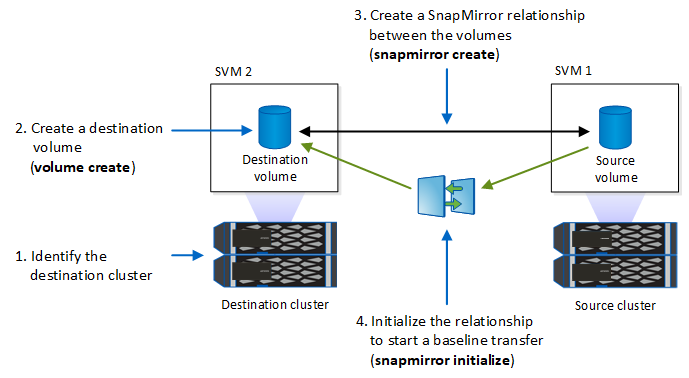Mirroring WORM files
You can use SnapMirror to replicate WORM files to another geographic location for disaster recovery and other purposes. Both the source volume and destination volume must be configured for SnapLock, and both volumes must have the same SnapLock mode, Compliance or Enterprise. All key SnapLock properties of the volume and files are replicated.
Before you begin
The source and destination volumes must be created in peered clusters with peered SVMs. For more information, see the Cluster and SVM Peering Express Guide.
About this task
Starting with ONTAP 9.5, you can replicate WORM files with the XDP (extended data protection) type SnapMirror relationship rather than the DP (data protection) type relationship. XDP mode is ONTAP version-independent, and is able to differentiate files stored in the same block, making it much easier to resync replicated Compliance-mode volumes. For information on how to convert an existing DP-type relationship to an XDP-type relationship, see the Data Protection Power Guide.
A resync operation on a DP type SnapMirror relationship fails for a Compliance-mode volume if SnapLock determines that it will result in a loss of data. If a resync operation fails, you can use the volume clone create command to make a clone of the destination volume. You can then resync the source volume with the clone.
A SnapMirror relationship of type XDP between SnapLock compliant volumes supports a resync after a break even if data on the destination has diverged from the source post the break.
On a resync, when data divergence is detected between the source the destination beyond the common snapshot, a new snapshot is cut on the destination to capture this divergence. The new snapshot and the common snapshot are both locked with a retention time as follows:- The volume expiry time of the destination
- If the volume expiry time is in the past or has not been set, then the snapshot is locked for a period of 30 days
- If the destination has legal-holds, the actual volume expiry period is masked and shows up as ‘indefinite’, however the snapshot is locked for the duration of the actual volume expiry period.
If the destination volume has an expiry period that is later than the source, the destination expiry period is retained and will not be overwritten by the expiry period of the source volume post the resync.
If the destination has legal-holds placed on it that differ from the source, a resync is not allowed. The source and destination must have identical legal-holds or all legal-holds on the destination must be released before a resync is attempted.
A locked snapshot on the destination volume created to capture the divergent data can be copied to the source by running the snapmirror update -s snapshot command. The snapshot once copied will continue to be locked at the source as well.
SVM data protection relationships are not supported.
Load-sharing data protection relationships are not supported.
The following illustration shows the procedure for initializing a SnapMirror relationship:
